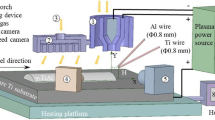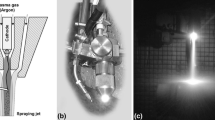Abstract
In twin-wire arc spraying (TWAS), the in-flight particles are atomized from a melting bath which generates an inhomogeneous spraying plume. This inhomogeneity is due to the fact that these particles are generated by the impingement of fast continuous flowing air upon the melting tips of electrically conductive wires. This work aims to contribute to the understanding of the initiation of such particles in the TWAS process. For this purpose, cored wires filled with W-rich particles were sprayed. After interrupting the TWAS process, the tips of these cored wires were imaged by 3D µCT and scanning electron microscopy in order to analyze how the filling powder interacts with the melted part of the sheath. The analysis of the 3D tomograms shows that the resolidified melting bath of the cored wires is interspersed with both spherical and irregular-shaped W-rich particles. This irregular shape suggests a partial melting of the W-rich particles.









Similar content being viewed by others
References
W. Tillmann, E. Vogli, I. Baumann, and B. Krebs, Novel Densification and Smoothing Techniques of Thermal Sprayed Layers, A. Kobayashi, Ed., Smart Processing Technology, Vol 2, The High Temperature Society of Japan
W. Tillmann, E. Vogli, and M. Abdulgader, The Correlation Between the Coating Quality and the Moving Direction of the Twin Wire Arc Spraying Gun, J. Therm. Spray Technol., 2010, 19(1–2), p 409-421
A. Newbery and P. Grant, Arc Sprayed Steel: Microstructure in Severe Substrate Features, J. Therm. Spray Technol., 2009, 18(2), p 256-271
D. Sacriste, N. Goubot, J. Dhers, M. Ducos, and A. Vardelle, An Evaluation of the Electric Arc Spray and (HPPS) Processes for the Manufacturing of High Power Plasma Spraying MCrAIY Coatings, J. Therm. Spray Technol., 2001, 10(2), p 352-358
A. Mansour and N. Chigier, Disintegration of Liquid Sheets, Phys. Fluids A, 1990, 2(5), p 706-719
H. Liao, Y. Zhu, R. Bolot, C. Coddet, and S. Ma, Size Distribution of Particles from Individual Wires and the Effects of Nozzle Geometry in Twin Wire Arc Spraying, Surf. Coat. Technol., 2005, 200(7), p 2123-2130
A. Newbery, P. Grant, and R. Neiser, The Velocity and Temperature of Steel Droplets During Electric Arc Spraying, Surf. Coat. Technol., 2005, 195(1), p 91-101
A. Pourmousa, J. Mostaghimi, A. Abedini, and S. Chandra, Particle Size Distribution in a Wire-Arc Spraying System, J. Therm. Spray Technol., 2005, 14(4), p 502-510
N.A. Hussary and J.V.R. Heberlein, Effect of System Parameters on Metal Breakup and Particle Formation in the Wire Arc Spray Process, J. Therm. Spray Technol., 2007, 16(1), p 140-152
H. Steffens, Haftung und Schichtaufbau beim Lichtbogen- und Flammspritzen (Adhesion and layer structure for arc and flame spraying), Ph.D. Thesis, Universität Hannover, 1963
N. Hussary and J. Heberlein, Atomization and Particle-Jet Interactions in the Wire-Arc Spraying Process, J. Therm. Spray Technol., 2001, 10(4), p 604-610
X. Wang, J. Heberlein, E. Pfender, and W. Gerberich, Effect of Nozzle Configuration, Gas Pressure, and Gas Type on Coating Properties in Wire Arc Spray, J. Therm. Spray Technol., 1999, 8(4), p 565-575
J. Wilden, J. Bergmann, S. Jahn, S. Knapp, F. Rodijnen, and G. Fischer, Investigation about the Chrome Steel Wire Arc Spray Process and the Resulting Coating Properties, J. Therm. Spray Technol., 2007, 16(5–6), p 759-767
W. Tillmann, E. Vogli, and M. Abdulgader, Asymmetric Melting Behavior in Twin Wire Arc Spraying with Cored Wires, J. Therm. Spray Technol., 2008, 17(5–6), p 974-982
S. Mates and G. Settles, A Study of Liquid Metal Atomization Using Close-Coupled Nozzles, Part 1: Gas Dynamic Behavior, At. Sprays, 2005, 15, p 19-40
V. Guipont, G. Rolland, M. Jeandin, C. Peyrega, D. Jeulin, and W. Ludwig, Microstructures of Cold-Sprayed Coatings Investigated by X-Ray Microtomography, Therm. Spray Bull., 2010, 2, p 140-147
W. Tillmann, J. Nellesen, and M. Abdulgader, Microtomographic Analysis of Splat Formation and Layer Build-Up of a Thermally Sprayed Coating, J. Therm. Spray Technol., 2012, 21(3–4), p 514-521
P. Ctibor, R. Lechnerová, and V. Beneš, Quantitative Analysis of Pores of Two Types in a Plasma-Sprayed Coating, Mater. Charact., 2006, 56, p 297-304
A. Kulkarni, S. Sampath, A. Goland, H. Herman, and B. Dowd, Computed Microtomography Studies to Characterize Microstructure Property Correlations in Thermal Sprayed Alumina Deposits, Scr. Mater., 2000, 43, p 471-476
A.A. Kulkarni, A. Goland, H. Herman, A.J. Allen, J. Ilavsky, G.G. Long, and F. De Carlo, Advanced Microstructural Characterization of Plasma-Sprayed Zirconia Coatings Over Extended Length Scales, J. Therm. Spray Technol., 2005, 14(2), p 239-250
J. Ilavsky, Characterization of Complex Thermal Barrier Deposits Pore Microstructures by a Combination of Imaging, Scattering, and Intrusion Techniques, J. Therm. Spray Technol., 2010, 19, p 178-189
L. Feldkamp, L. Davis, and J. Kress, Practical Cone Beam Algorithm, J. Opt. Soc. Am. A, 1984, 1, p 612-619
Acknowledgments
The authors gratefully acknowledge the financial support of the DFG (German Research Foundation) within the Collaborative Research Center SFB 708 TP/B3.
Author information
Authors and Affiliations
Corresponding author
Additional information
This article is an invited paper selected from presentations at the 2014 International Thermal Spray Conference, held May 21-23, 2014, in Barcelona, Spain, and has been expanded from the original presentation.
Rights and permissions
About this article
Cite this article
Nellesen, J., Abdulgader, M., Tillmann, W. et al. 3D µCT and SEM Analysis of Resolidified Tips of Cored Wires Used in Twin-Wire Arc Spraying. J Therm Spray Tech 24, 55–62 (2015). https://doi.org/10.1007/s11666-014-0169-z
Received:
Revised:
Published:
Issue Date:
DOI: https://doi.org/10.1007/s11666-014-0169-z




